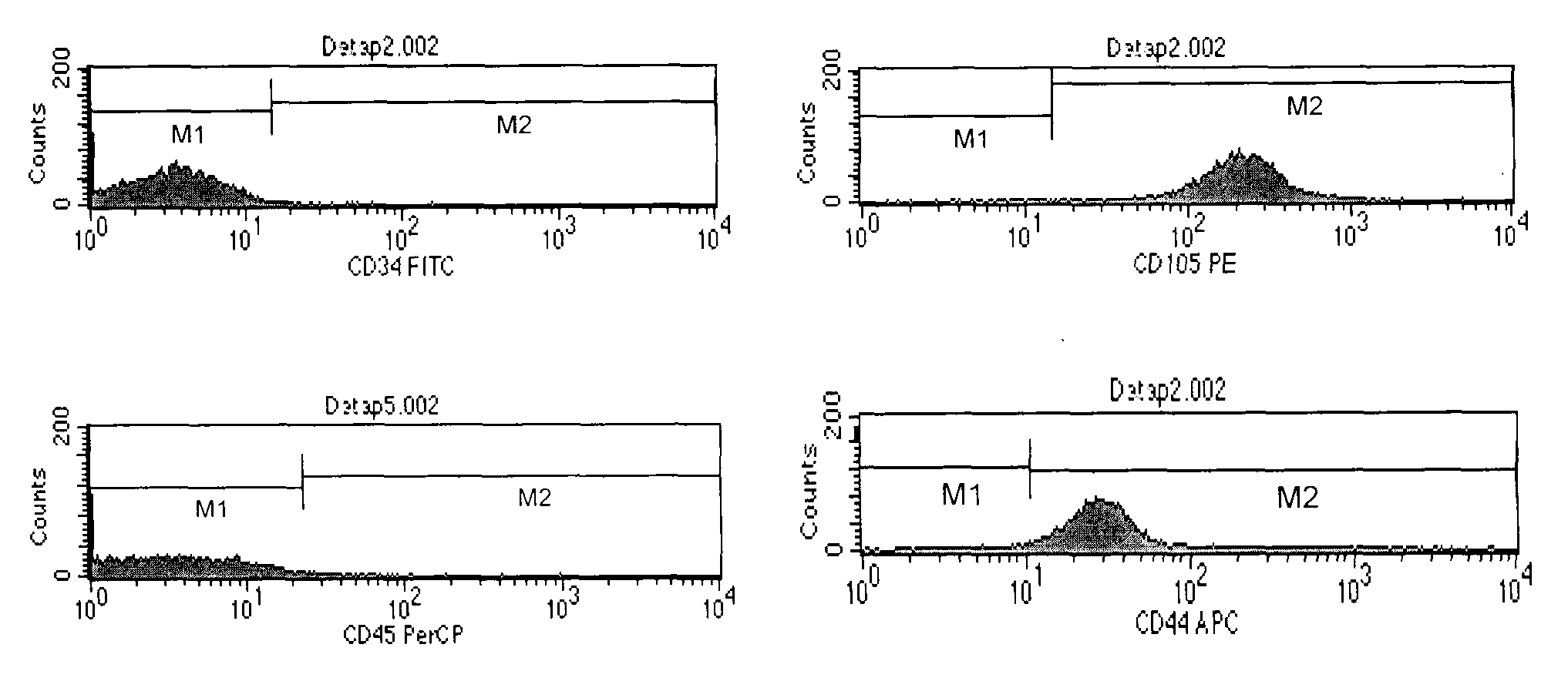Method for separating and culturing human umbilical cord mesenchymal stem cells
A quality stem cell, separation and culture technology, applied in the field of biological product cell separation and culture, to achieve the effects of simple and efficient operation, low cost and cost saving
- Summary
- Abstract
- Description
- Claims
- Application Information
AI Technical Summary
Problems solved by technology
Method used
Image
Examples
Embodiment 1
[0027] Take about 15ml of the umbilical cord of the full-term cesarean section fetus, and wash it repeatedly with PBS under sterile conditions to remove the residual blood. In RPMI MEDIUM 1640 medium, use sterile scissors to cut it into a tissue piece about 1.0 cm in length, remove the blood vessel and cut it as much as possible, put the tissue piece in a 50ml centrifuge tube, mix thoroughly with RPMI MEDIUM 1640 medium, and then centrifuge. The speed of the centrifuge is 2000 rpm, centrifuge for 5 minutes, discard the supernatant, and repeat 3 times. After centrifugation, about 20ml of umbilical cord tissue fragments are obtained, and the centrifuged sediment is mixed with MesenCult-XFMediums complete medium and shaken to evenly plant on the cells Petri dish and place at 37 °C, 5% CO 2 in the incubator. On the 5th day of culture, all the tissue pieces were sucked out and discarded, and the culture medium was added, and adherent spindle-shaped or polygonal cells were observed...
Embodiment 2
[0029] Take about 30ml of the umbilical cord of the full-term cesarean section fetus, and wash it repeatedly with PBS under sterile conditions to remove the residual blood. Use sterile scissors in DMEM medium to cut tissue pieces about 1.5 cm in length, remove the blood vessels and cut them into pieces as much as possible. Put the tissue pieces in a 50ml centrifuge tube, mix and oscillate fully with DMEM medium, and then centrifuge. The centrifuge speed is Centrifuge at 1600 rpm for 10 minutes, discard the supernatant, and repeat 4 times to obtain about 30ml of umbilical cord tissue fragments. Mix and shake the centrifuged part with MesenCult-XF Mediums complete medium and plant it evenly in a cell culture dish, and place 37°C, 5% CO 2 in the incubator. On the 5th day of culture, all the tissue pieces were sucked out and discarded, and the culture medium was added, and adherent spindle-shaped or polygonal cells were observed under the microscope, and the culture medium was re...
Embodiment 3
[0031]Take about 15ml of the umbilical cord of the full-term cesarean section fetus, and wash it repeatedly with PBS under sterile conditions to remove the residual blood. In RPMI MEDIUM 1640 medium, use sterile scissors to cut it into a tissue piece about 1.5cm long, remove its blood vessels and use a tissue homogenizer to fully and thoroughly mince it, and place the tissue homogenate in a 50ml centrifuge tube after mincing Mix well with RPMI MEDIUM 1640 medium and then centrifuge at a speed of 2200 rpm, centrifuge for 10 minutes, discard the supernatant, and repeat twice to obtain about 40ml of umbilical cord tissue fragments. Mediums complete medium mixed and shaken evenly planted in T-75cm 2 culture flask and place at 37 °C, 5% CO 2 in the incubator. On the 5th day of culture, all the tissue pieces were sucked out and discarded, and the culture medium was added, and adherent spindle-shaped or polygonal cells were observed under the microscope, and the culture medium was ...
PUM
 Login to View More
Login to View More Abstract
Description
Claims
Application Information
 Login to View More
Login to View More - R&D
- Intellectual Property
- Life Sciences
- Materials
- Tech Scout
- Unparalleled Data Quality
- Higher Quality Content
- 60% Fewer Hallucinations
Browse by: Latest US Patents, China's latest patents, Technical Efficacy Thesaurus, Application Domain, Technology Topic, Popular Technical Reports.
© 2025 PatSnap. All rights reserved.Legal|Privacy policy|Modern Slavery Act Transparency Statement|Sitemap|About US| Contact US: help@patsnap.com


